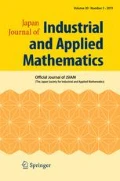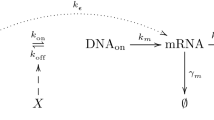Abstract
A macroscopic kinetic equation of only four variables for a simple genetic algorithm (SGA) with an on-off type of replication operator and a crossover operator is developed and used to predict several types of evolutionary routes for a wide range of metabolic-ratecontrolling parameters, initial conditions, string lengths, population sizes, and environments. The four variables correspond to the probabilities of the best-adapted species and three mutant groups into which degenerate and redundant strings are classified according to the Hamming distance (HD). The time-dependent frequency distribution along the fitness value is given by an implicit formulation. The environment is also defined in the HD-fitness value space as the frequency distribution of all the possible types of strings without redundancy. It is found that the SGA possesses the capability for exploring quasimacroevolution.
Similar content being viewed by others
References
T. Back, Evolutionary algorithms. Computing with Biological Methaphors (ed. R. Pation), Chapman and Hall, London, 1994, 227–243.
G. Dietz, Experimentelle Untersuchungen zur Transitionslage an einem Profilmodell mit variabler Oberseiten Kontur in Kompressibler, Subsonischer Stromung. Diplomarbeit, Aerodynamishes Institut der RWTH Aachen, 1992.
G.M. Edelman, Neural Darwinism. Oxford Univ. Press, Oxford, 1989.
M. Eigen, J. MacCaskill and P. Schuster, The molecular quasi-species. Adv. in Chem. Phys.,75, John Wiley and Sons, New York, 1989, 149–263.
M. Eigen and R. Winkler, Das Spiel. R. Piper & Co. Verlag, Munchen, 1979.
D.E. Goldberg, Genetic Algorithms. Addison-Wesley, Reading, Massachusetts, 1989.
J.J. Grefenstette, Optimization of control parameters for genetic algorithms. IEEE Trans. Syst., Man & Cybern., (1986), 122–128.
W. Greuner, Evolutionary Optimization on RNA Folding Landscapes. Doctoral dissertation, Universitat Wien, 1994.
J.H. Holland, Adaption in Natural and Artificial Systems. The Univ. of Michigan Press, Ann Arbor, 1975.
S.A. Kauffman, The Origins of Order. Oxford Univ. Press, Oxford, 1993.
H. Kitano, Combination of genetic algorithm and neural network. Genetic Algorithm (ed. H. Kitano), Sangyo Tosho, Tokyo, 1993, 235–262.
A. Konagaya, Genetic algorithm for combination problems. Genetic Algorithm (ed. H. Kitano), Sangyo Tosho, Tokyo, 1993, 133–162.
J.R. Koza, Genetic Programming. MIT Press, Cambridge, 1993.
E.N. Lorentz, Deterministic non-periodic flows. J. Atmos. Sci.,20 (1963), 130–141.
I. Rechenberg, Evolutionalstrategie. Frommann-Holzboog Verlag, Stuttgart, 1973.
J.M. Smith, Evolutionary Genetics. Oxford Univ. Press, Oxford, 1992.
M.D. Vose and G.E. Liepins, Punctuated equilibria in genetic search. Complex Systems,5 (1991), 31–44.
Author information
Authors and Affiliations
About this article
Cite this article
Naitoh, K. Macroscopic kinetic equation for a genetic algorithm. Japan J. Indust. Appl. Math. 15, 87–133 (1998). https://doi.org/10.1007/BF03167398
Received:
Revised:
Issue Date:
DOI: https://doi.org/10.1007/BF03167398



